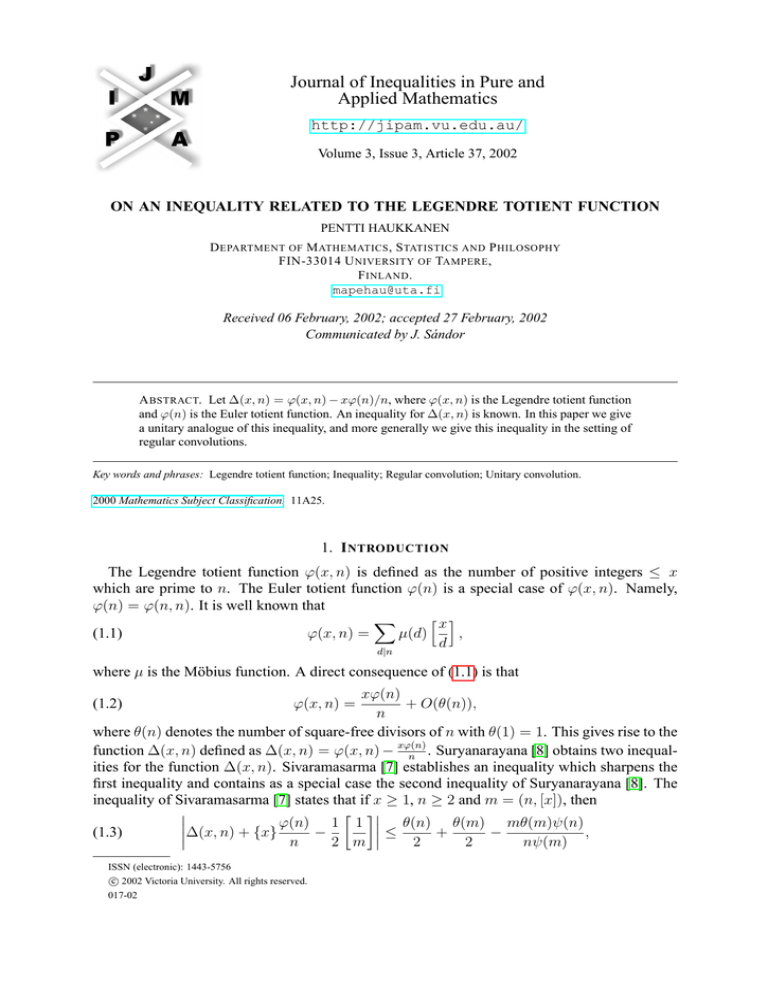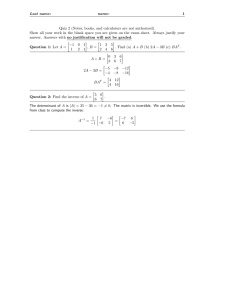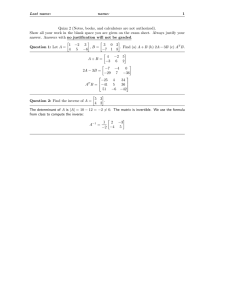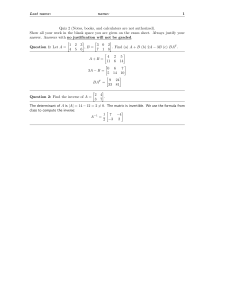
Journal of Inequalities in Pure and
Applied Mathematics
http://jipam.vu.edu.au/
Volume 3, Issue 3, Article 37, 2002
ON AN INEQUALITY RELATED TO THE LEGENDRE TOTIENT FUNCTION
PENTTI HAUKKANEN
D EPARTMENT OF M ATHEMATICS , S TATISTICS AND P HILOSOPHY
FIN-33014 U NIVERSITY OF TAMPERE ,
F INLAND .
mapehau@uta.fi
Received 06 February, 2002; accepted 27 February, 2002
Communicated by J. Sándor
A BSTRACT. Let ∆(x, n) = ϕ(x, n) − xϕ(n)/n, where ϕ(x, n) is the Legendre totient function
and ϕ(n) is the Euler totient function. An inequality for ∆(x, n) is known. In this paper we give
a unitary analogue of this inequality, and more generally we give this inequality in the setting of
regular convolutions.
Key words and phrases: Legendre totient function; Inequality; Regular convolution; Unitary convolution.
2000 Mathematics Subject Classification. 11A25.
1. I NTRODUCTION
The Legendre totient function ϕ(x, n) is defined as the number of positive integers ≤ x
which are prime to n. The Euler totient function ϕ(n) is a special case of ϕ(x, n). Namely,
ϕ(n) = ϕ(n, n). It is well known that
hxi
X
(1.1)
ϕ(x, n) =
µ(d)
,
d
d|n
where µ is the Möbius function. A direct consequence of (1.1) is that
xϕ(n)
+ O(θ(n)),
n
where θ(n) denotes the number of square-free divisors of n with θ(1) = 1. This gives rise to the
function ∆(x, n) defined as ∆(x, n) = ϕ(x, n) − xϕ(n)
. Suryanarayana [8] obtains two inequaln
ities for the function ∆(x, n). Sivaramasarma [7] establishes an inequality which sharpens the
first inequality and contains as a special case the second inequality of Suryanarayana [8]. The
inequality of Sivaramasarma [7] states that if x ≥ 1, n ≥ 2 and m = (n, [x]), then
ϕ(n)
1
1 θ(n) θ(m) mθ(m)ψ(n)
∆(x, n) + {x}
(1.3)
−
≤
+
−
,
n
2 m 2
2
nψ(m)
(1.2)
ϕ(x, n) =
ISSN (electronic): 1443-5756
c 2002 Victoria University. All rights reserved.
017-02
2
P ENTTI H AUKKANEN
where {x} = x − [x] and ψ is the Dedekind totient function. See also [4, §I.32].
In this paper we give (1.3) in the setting of Narkiewicz’s regular convolution and the kth
power greatest common divisor. As special cases we obtain (1.3) and its unitary analogue. The
proof is adapted from that given by Sivaramasarma [7].
2. P RELIMINARIES
For each n let A(n) be a subset of the set of positive divisors of n. The elements of A(n)
are said to be the A-divisors of n. The A-convolution of two arithmetical functions f and g is
defined by
n
X
(f ∗A g)(n) =
f (d)g
.
d
d∈A(n)
Narkiewicz [5] (see also [3]) defines an A-convolution to be regular if
(a) the set of arithmetical functions forms a commutative ring with unity with respect to the
ordinary addition and the A-convolution,
(b) the A-convolution of multiplicative functions is multiplicative,
(c) the constant function 1 has an inverse µA with respect to the A-convolution, and µA (n) =
0 or −1 whenever n is a prime power.
It can be proved [5] that an A-convolution is regular if and only if
(i) A(mn) = {de : d ∈ A(m), e ∈ A(n)} whenever (m, n) = 1,
(ii) for each prime power pa (> 1) there exists a divisor t = τA (pa ) of a such that
A(pa ) = 1, pt , p2t , . . . , prt ,
where rt = a, and
A(pit ) = 1, pt , p2t , . . . , pit , 0 ≤ i < r.
The positive integer t = τA (pa ) in part (ii) is said to be the A-type of pa . A positive integer n
is said to be A-primitive if A(n) = {1, n}. The A-primitive numbers are 1 and pt , where p runs
through the primes and t runs through the A-types of the prime powers pa with a ≥ 1.
For all n let D(n) denote the set of all positive divisors of n and let U (n) denote the set of all
unitary divisors of n, that is,
n
n
o
U (n) = d > 0 : d n, d,
= 1 = {d > 0 : d k n}.
d
The D-convolution is the classical Dirichlet convolution and the U -convolution is the unitary
convolution [1]. These convolutions are regular with τD (pa ) = 1 and τU (pa ) = a for all prime
powers pa (> 1).
Let k be a positive integer. We denote Ak (n) = d > 0 : dk ∈ A nk . It is known [6] that
the Ak -convolution is regular whenever the A-convolution is regular. The symbol (m, n)A,k
denotes the greatest kth power divisor of m which belongs to A(n). In particular, (m, n)D,1 is
the usual greatest common divisor (m, n) of m and n, and (m, n)U,1 , usually written as (m, n)∗ ,
is the greatest unitary divisor of n which is a divisor of m.
Throughout the rest of the paper A will be an arbitaray but fixed regular convolution and k is
a positive integer.
The A-analogue of the Möbius function µA is the multiplicative function given by
−1 if pa (> 1) is A-primitive,
a
µA (p ) =
0 if pa is non-A-primitive.
In particular, µD = µ, the classical Möbius function, and µU = µ∗ , the unitary analogue of the
Möbius function [1].
J. Inequal. Pure and Appl. Math., 3(3) Art. 37, 2002
http://jipam.vu.edu.au/
O N AN I NEQUALITY R ELATED TO THE L EGENDRE T OTIENT F UNCTION
3
The generalized Legendre totient function ϕA,k (x, n) is defined as the number of positive
integers a ≤ x such that (a, nk )A,k = 1. It is known [2] that
hxi
X
µAk (d) k .
(2.1)
ϕA,k (x, n) =
d
d∈Ak (n)
In particular, ϕA,k (n) = ϕA,k (nk , n). We recall that
Y
(2.2)
ϕA,k (n) = nk
1 − p−tk ,
p|n
where n = p pn(p) is the canonical factorization of n and t = τAk (pn(p) ), and we define the
generalized Dedekind totient function ψA,k as
Y
1 + p−tk .
(2.3)
ψA,k (n) = nk
Q
p|n
If A is the Dirichlet convolution and k = 1, then ϕA,k (x, n), ϕA,k (n) and ψA,k (n), respectively,
reduce to the Legendre totient function, the Euler totient function and the Dedekind totient
function.
It follows from (2.1) that
x
X
ϕA,k (x, n) =
µAk (d) k + O(1)
d
d∈Ak (n)
X
xϕA,k (n)
=
+O
µ2Ak (d)
nk
d∈Ak (n)
=
xϕA,k (n)
+ O(θ(n)).
nk
This suggests we define
xϕA,k (n)
.
nk
We next present four lemmas which are needed in the proof of our inequality for the function
∆A,k (x, n).
n [x] o
k
Lemma 2.1. If f x, n = nk and mk = [x], nk A,k , then
(i) f x, nk = 0 if m = n,
k
k
(ii) m
≤ f (x, nk ) ≤ 1 − m
if m < n.
nk
nk
n o
k
Proof.
(i) If m = n, then n |[x] and thus n[x]k = 0.
∆A,k (x, n) = ϕA,k (x, n) −
(2.4)
k
k
k
(ii) n
Let m
o < n. Then n 6 | [x] and thus [x] = an + r,
n where
o 0 < r < n . Therefore
[x]
= nrk , where 0 < r < nk , that is, n1k ≤ n[x]k ≤ 1 − n1k . Now, writing
nk
[x]
nk
=
([x]/mk )
(nk /mk )
we arrive at our result.
Lemma 2.2. For n ≥ 2
X
d∈Ak (n)
ω(d) is odd
µ2Ak (d) =
θ(n)
,
2
where ω(d) is the number of distinct prime divisors of d.
J. Inequal. Pure and Appl. Math., 3(3) Art. 37, 2002
http://jipam.vu.edu.au/
4
P ENTTI H AUKKANEN
Proof. It is clear that
X
µ2Ak (d)
=
d∈Ak (n)
ω(d) is odd
ω(n)
ω(n)
θ(n)
+
+ · · · = 2ω(n)−1 =
.
1
3
2
Lemma 2.3. Let mk = ([x], nk )A,k . Then
X µ2A (d)([x], dk )A,k
mk θ(m)ψA,k (n)
k
=
.
dk
nk ψA,k (m)
d∈Ak (n)
Proof. By multiplicativity it is enough to consider the case in which n is a prime power. For the
sake of brevity we do not present the details.
Lemma 2.4. We have
∆A,k (x, n) + {x}
X
ϕA,k (n)
=
−
µAk (d)f (x, dk ).
nk
d∈Ak (n)
Proof. Clearly
ϕA,k (x, n) =
X
µAk (d)
x
d∈Ak (n)
dk
−
n x o
dk
nxo
X
xϕA,k (n)
=
−
µAk (d) k .
nk
d
d∈Ak (n)
Thus
X
∆A,k (x, n) = −
µAk (d)
d∈Ak (n)
It can be verified that
x
dk
=
{x}
dk
nxo
dk
.
n o
+ [x]
. Thus
dk
X
ϕA,k (n)
[x]
∆A,k (x, n) = −{x}
−
µAk (d)
.
k
n
dk
d∈Ak (n)
This completes the proof.
3. G ENERALIZATION
OF
(1.3)
Theorem 3.1. Let x ≥ 1, n ≥ 2 and mk = ([x], nk )A,k . Then
ϕA,k (n) 1 1 θ(n) θ(m) mk θ(m)ψA,k (n)
(3.1)
∆A,k (x, n) + {x} nk − 2 m ≤ 2 + 2 − nk ψA,k (m) .
Proof. Firstly, suppose that m = n, that is, nk | [x]. Then
X µA (d)[x]
ϕA,k (n)
k
ϕA,k (x, n) =
= [x]
.
k
d
nk
d∈Ak (n)
Thus
{x}ϕA,k (n)
= 0.
nk
Since n ≥ 2, the left-hand side of (3.1) is = 0. Therefore (3.1) holds.
∆A,k (x, n) +
J. Inequal. Pure and Appl. Math., 3(3) Art. 37, 2002
http://jipam.vu.edu.au/
O N AN I NEQUALITY R ELATED TO THE L EGENDRE T OTIENT F UNCTION
Secondly, suppose that 1 ≤ m < n. Then, by Lemma 2.4,
X
{x}ϕA,k (n)
=
µ2Ak (d)f (x, dk ) −
∆A,k (x, n) +
k
n
d∈A (n)
k
ω(d) is odd
X
5
µ2Ak (d)f (x, dk ).
d∈Ak (n)
ω(d) is even
By Lemma 2.1,
{x}ϕA,k (n)
nk
X
([x], dk )A,k
2
≤
µAk (d) 1 −
−
k
d
d∈A (n)
∆A,k (x, n) +
k
ω(d) is odd
k
d 6 |[x]
X
=
µ2Ak (d) −
d∈Ak (n)
ω(d) is odd
−
X
X
d∈Ak (n)
ω(d) is even
dk 6 |[x]
µ2Ak (d)
([x], dk )A,k
dk
µ2Ak (d)
d∈Ak (n)
ω(d) is odd
dk |[x]
X
µ2Ak (d)
d∈Ak (n)
X
([x], dk )A,k
([x], dk )A,k
2
+
µ
(d)
.
Ak
dk
dk
d∈A (n)
k
dk |[x]
By Lemmas 2.2 and 2.3 and definition of the number m,
X
{x}ϕA,k (n)
θ(n)
mk θ(m)ψA,k (n)
2
+ θ(m).
∆A,k (x, n) +
≤
−
µAk (d) −
nk
2
nk ψA,k (m)
d∈A (m)
k
ω(d) is odd
We distinguish the cases m = 1 and m > 1 and apply Lemma 2.2 in the case m > 1 to obtain
{x}ϕA,k (n) 1 1
θ(n) θ(m) mk θ(m)ψA,k (n)
∆A,k (x, n) +
−
≤
+
−
.
nk
2 m
2
2
nk ψA,k (m)
In a similar way we can show that
{x}ϕA,k (n) 1 1
θ(n) θ(m) mk θ(m)ψA,k (n)
∆A,k (x, n) +
−
≥
−
−
+
.
nk
2 m
2
2
nk ψA,k (m)
This completes the proof.
Remark 3.2. If A is the Dirichlet convolution and k = 1, then (3.1) reduces to (1.3).
4. U NITARY A NALOGUE OF (1.3)
We recall that a positive
integer d is said to be a unitary divisor of n (written as dkn) if d is a
n
divisor of n and d, d = 1. The unitary analogue of the Legendre totient function ϕ∗ (x, n) is
the number of positive integers a ≤ x such that (a, n)∗ = 1. Its arithmetical expression is
hxi
X
ϕ∗ (x, n) =
µ∗ (d)
.
d
dkn
In particular, the unitary analogue of the Euler totient function is given by ϕ∗ (n) = ϕ∗ (n, n).
We define the unitary analogue of the Dedekind totient function as
Y
ψ ∗ (n) = n
(1 + p−e ).
pe kn
It is easy to see that ψ ∗ (n) = σ ∗ (n), where σ ∗ (n) is the sum of the unitary divisors of n. The
∗
function ∆∗ (x, n) is defined as ∆∗ (x, n) = ϕ∗ (x, n) − xϕn(n) .
J. Inequal. Pure and Appl. Math., 3(3) Art. 37, 2002
http://jipam.vu.edu.au/
6
P ENTTI H AUKKANEN
The unitary analogue of (1.3) is
∗
∗
1
1 θ(n) θ(m) mθ(m)σ ∗ (n)
ϕ
(n)
(4.1)
∆ (x, n) + {x} n − 2 m ≤ 2 + 2 − nσ ∗ (m) ,
where m = ([x], n)∗ . In fact, if A is the unitary convolution and k = 1, then (3.1) reduces to
(4.1).
R EFERENCES
[1] E. COHEN, Arithmetical functions associated with the unitary divisors of an integer, Math. Z. 74
(1960), 66–80.
[2] P. HAUKKANEN, Some generalized totient functions, Math. Stud. 56 (1988), 65–74.
[3] P.J. McCARTHY, Introduction to Arithmetical Functions, Springer–Verlag, New York, 1986.
[4] D.S. MITRINOVIĆ, J. SÁNDOR AND B. CRSTICI, Handbook of Number Theory, Kluwer Academic Publishers, MIA Vol. 351, 1996.
[5] W. NARKIEWICZ, On a class of arithmetical convolutions, Colloq. Math., 10 (1963), 81–94.
[6] V. SITA RAMAIAH, Arithmetical sums in regular convolutions, J. Reine Angew. Math., 303/304
(1978), 265–283.
[7] A. SIVARAMASARMA, On ∆(x, n) = ϕ(x, n) − xϕ(n)/n, Math. Stud., 46 (1978), 160–164.
[8] D. SURYANARAYANA, On ∆(x, n) = ϕ(x, n) − xϕ(n)/n, Proc. Amer. Math. Soc., 44 (1974),
17–21.
J. Inequal. Pure and Appl. Math., 3(3) Art. 37, 2002
http://jipam.vu.edu.au/







